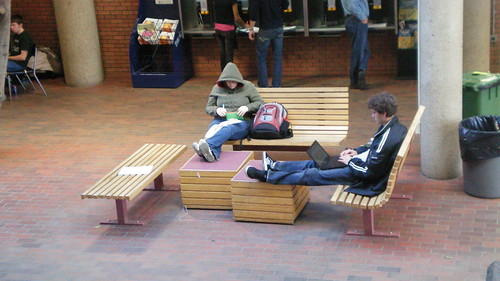Wi-Fi Territory
No post anterior falava de território informacional e de como o ciberespaço está sendo “baixado” para as coisas. Agora vejo esse excelente post do City of Sound, criando visualizações por desenhos e gráficos dos processos territorializantes das redes wi-fi. O autor chama de “infozone”. Vejam como a imbricação de redes wi-fi nos espaços redimensionam os lugares e o uso do corpo pelos usuários de redes sem fio públicas. Podemos aqui não só perceber, como visualizar a territorialização informacional e as novas heterotopias dos lugares na fase atual da cibercultura. Vejam abaixo trecho do post, “Wi-fi structures and people shapes”, do Dan Hill (trecho, desenhos e mapas). As fotos são minhas, feitas no intuito de observar o uso dos espaços na University of Alberta, Canada:

“(…) One of the ideas I’ve been exploring relates to how urban industry – in the widest sense of the word – in the knowledge economy is often invisible, at least immediately and in situ. Whereas urban industry would once have produced thick plumes of smoke or deafening sheets of sound, today’s information-rich environments – like the State Library of Queensland, or a contemporary office – are places of still, quiet production, with few sensory side-effects. We see people everywhere, faces lit by their open laptops, yet no evidence of their production. They could be using Facebook, Photoshop, Excel or Processing. (…)

So as well as photo-essays, videos and in-depth interviews with users, and relating to this idea of making the invisible, visible, I mapped the strength of the wi-fi signal across levels 1 and 2 of the Library, the primary areas that the Library’s wi-fi is used. By taking readings across the floor of both levels, using standard wi-fi-enabled consumer equipment in order to mimic the conditions for the average user (in this case a MacBook laptop and a Nokia e65 mobile phone), I was able to construct a snapshot of the wi-fi signal strength across the Library. (…)
(…) Constructing another tangent on the wi-fi, I was struck by how users adopted the Infozone space – where the wi-fi is primarily located – and the furniture provided for them. The low desks, small tables, various chairs, benches etc. afford numerous variations for wi-fi users, and sure enough people drape themselves all over them. (…)
As well as the hundreds of photos I took in the space, I decided to do a few sketches of the more interesting positions, which I suggested might work something like a aircraft identification manual or compendium yoga positions perhaps. With the latter in mind, I was tempted to name a few, such as “The perch”, “The front crawl”, “The huddle”, “The sandwich”, “Battleships”, “Reverse Battleships”, “The Horse”, “Side saddle”, “Lotus”, “The NASA control room”, “The occasional-table hug” and so on.

